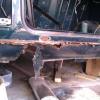Hi there. So are you saying it was fine, and then this has popped up quite suddenly? Not sure what the outside temperature would have to do with it,maybe that is just co-incidence. First the hissing sound. Is this new? Are you sure it isn't just a noisy alternator bearing or fan belt noise? - that can sound a bit like a hissing noise, and would appear to come from the passenger side. if you wanted to rule that out, then if you trickle some water on the fan belt while the engine is running (be very careful not to get your hands anywhere near the moving belt / alternator!) then it should go quiet or alot quieter.
The biggest cause of a vacuum leak on an SPi is a split vacuum pipe or rubber elbow, on the pipe that runs from the inlet manifold to the ECU MAP sensor. There is a short pipe from the back of the inlet manifold to a fuel trap (little black box near the air filter box) then a long pipe from the other leg of the fuel trap to the ECU. Check this first. Initially you are looking to make sure it hasn't popped off at the ECU end, or have any obvious splits. Next easiest thing is probably to pop it off at the ECU end and with the engine running (it will run rough) put your finger over the pipe, you should feel vacuum. If not, then there is a break somewhere in the line I described above, and you need to find it - could be anywhere from the connection at the back of the inlet manifold down to the connection at the ECU. Look for split rubber connectors as the most likely cause. Remember to put this pipe back on when you are finished.
There is also another pipe ( should be a red one) which comes off the inlet manifold at the back, next to the one described above. Assuming you have a standard air filter box, this one goes to a valve on the bottom of the air filter box. If you have a non standard box, this pipe should be blanked off (usually by putting a screw in it). Basically, the vacuum present on the red pipe will be passed to the yellow pipe coming out of this valve when the engine is cold - the yellow pipe attaches to a diverter flap which takes warm air off a little metal bracket under the intake pipe. Once the engine heats up the valve closes and the vacuum is not passed through, so the diverter flap closes and cold air is taken by the intake. Like with the other pipe to the ECU, any leak from the back of the manifold right down to the diverter flap could give you a vacuum leak. Again, you can use your finger over the end to test these pipes and see if there is vacuum there.
Other areas you could get a vacuum leak include the brake servo. There is a fairly large plastic hose connects to the black circular housing of the brake servo, this comes off the inlet manifold too. It just pops into the servo with a rubber seal. If that hose has come out or split, then you could get a big leak there. If it is that, then it really should be quite obvious.
Only other place I can think off would be the hose that runs to the charcoal canister purge valve. You'll see it running along the back of the rocker cover, and ending up attached to a square valve with an electrical connector on it, mounted near the wiper motor. This valve opens periodically to purge the charcoal fuel canister under the wing, however I think this could only cause a continuous vacuum leak if there was a split in the pipe between the purge valve and the inlet manifold - if there was a split in the pipe between the charcoal cansiter and the purge valve then that would only show up when the valve is opened by the ECU, which only happens under specific conditions (eg when driving).
Hope this gives you something to get started on, report back with any findings.
Edited by carlukemini, 17 February 2015 - 05:19 PM.


















